Author: Bruce McGlashan ([email protected])
First published in the OVA Newsletter (January 2025).
In my article in the last OVA Newsletter. I highlighted a number of issues that are negatively impacting the ecology of the River Otter. Just a reminder if you needed one, that currently no single stretch of the river is assessed as being of good ecological quality under the Water Framework Directive (WFD) by the Environment Agency (EA) and three of them, the Middle and Lower sections of the main river and the River Wolf one of Otter’s main tributaries are assessed as being in poor ecological health.
The EA has published the reason for these failures and you probably won’t be surprised to hear that poor water quality is the main one. Peter Williams article in this newsletter explores this further, along with the work being undertaken by OVA’s new Water Quality (WQ) Group and other partners to address it.
Important as the WQ improvement work is, it won’t unfortunately by itself result in all stretches of the river returning to good ecological health. This is because the WFD assessment considers a number of other criteria in additional to chemical water quality, fish and invertebrate populations being two. In several parts of the river these population are not what they should be, fish populations are for example considered to be poor in the Middle Otter and this consequently is one of the reasons why the overall ecological quality of that section is rated as poor. The reason for the poor fishing population, is you guessed it, partly poor water quality, but also the EA reports the presence of a number physical barriers in the river.
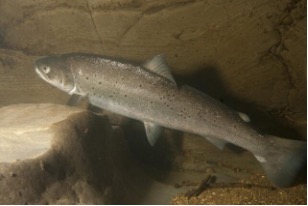 | Adult Sea Trout spend much of the lives at sea but return each year to the River Otter to spawn |
These barriers, have a number of negative impacts, particularly on fish such as salmon and sea trout and invertebrates’ population, but they can also impact a rivers water quality and hydromorphology - the physical features and characteristic of the river.
In this article I will provide a summary of the types of barriers on the Otter and where they can be found, explore in more detail their impacts and then in our next newsletter I will explain the work that is being carried out by ROFA and other partners to try and either remove the structure or if this not possible improve passage over it.
Types of Barrier on the Otter
First you may ask what the Barriers are I’m referring to, a problem that is far from unique to the Otter. The most obvious ones are dams, which thankfully other than a small one at Otterhead Lakes at the very top of the catchment are not a concern for us. Instead on the Otter the most significant barriers are weirs, often associated with existing or former water mills and water management schemes. There are several examples. Perhaps the most well-known, certainly on the lower river is the large weir serving Otterton Mill dating back to the 19th century. Other examples of large weirs on the river include Tipton Weir, Cadhays Weir and Tracey Weir. A number of less substantial weirs can also be found in the middle sections of the river and its tributaries including the River Tale, Budleigh Brook, The Gissage and the Wolf.
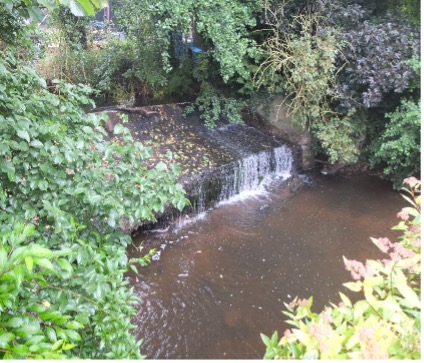 | 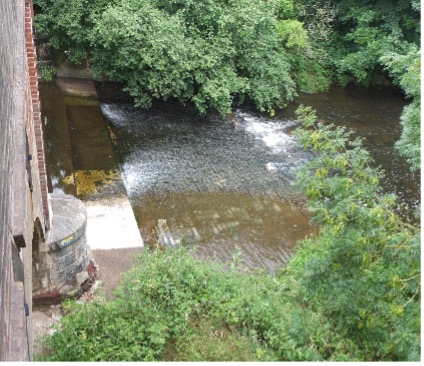 |
| This weir on the River Wolf Acts acts as a complete barrier to fish trying to access the middle and upper river | View of the apron of Fenny Bridge which acts as a partial barrier to fish |
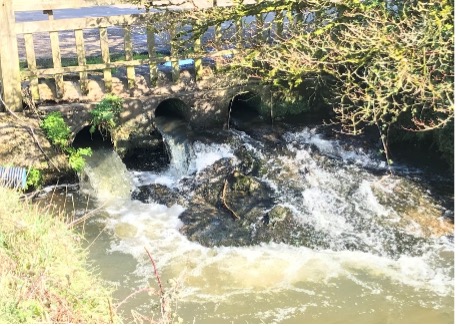 | 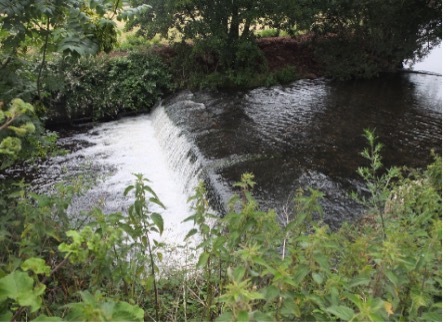 |
As example of Irish Bridge with water channelled through a series of fish unfriendly pipes on the R Love. | This weir in middle Otter one of a series of four in quick succession acts a partial barrier to fish particularly in low flow condition. |
Other barriers present on the Otter include bridges, or more specifically the apron/sill on which they sit. In other cases it is the way the bridge designers have chosen to allow water to pass under it. For example, low lying Irish Bridges, of which there are number on the river. These frequently use a series of low diameter pipe for this purpose, rather than a single channel. Fish are unfortunately reluctant /find it difficult to swim up these pipes and the bridge therefore act as barrier to fish movement upstream of it.
Another type of barrier and an ironic one given the EA responsibilities to improve fisheries, are several EA structures associated with flow monitoring gauging stations.
It is important to highlight that although some of the barriers on the Otter act as complete barriers to fish, most act as partial barriers and are passable to fish, but only if river conditions are suitable, an example being when river levels are elevated after heavy rainfall. Other barriers even though passable most of the time, require considerable energy from the fish to get over them. Individually this is not necessarily a problem, but the cumulative/ effect of a series of such barriers as is found on the Otter can be. Think of an obstacle course and the combined impact of scaling a number of obstacles on that course, one after another and you’ll understand why.
One other type of barrier, that is now appearing on many rivers particularly on the Otter is a more natural one. Namely Beaver dams. This however is a subject - an often contentious one at that – and one I will return to that in another article.
Impacts of Weirs on Fish and Aquatic Ecosystems
Having highlighted the types of barriers present on the river, I also wanted to explain here what the impact of these barriers is to amphibian life:
- Disrupted Fish Migration – with the most significant impact being on migratory fish species (both upstream and downstream) such as Atlantic salmon and sea trout and some less know species such as lampreys and potentially Shad. All these species require open rivers between the sea where they spend much of their adult lives and their spawning grounds which are often found far upstream in the headwaters of rivers. Although the most significant impact is on anadromous fish, - species that spends portions of their life cycle in both fresh and salt waters, barriers can also impact species such as our native brown trout that spend their whole lives in freshwater. This because brown trout if allowed will move considerable distances up and down stream, in search of suitable spawning gravels and feeding territories.
- Increased Predation – since fish delayed by weirs and other barriers often congregate in upstream pools or below the barrier until river conditions become more favourable to migration. This makes them easy prey for predators such as otters, herons, goosander and particularly cormorants.
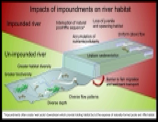 | 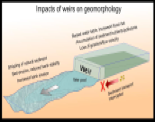 |
- Impact on Spawning Gravel - Salmonids, (Salmon and Trout) and many other fish species, require clean, oxygen-rich gravel beds for spawning. Weirs disrupt sediment transport, causing gravel to accumulate upstream while starving downstream habitats. This leads to degraded spawning areas and reduced juvenile survival rates.
- Altered River Hydromorphology - since weirs modify the physical characteristics of rivers, resulting in both upstream sediment accumulation, as well as channel incision and disconnection from the river flood plain. This then results in upstream sediment accumulation, and downstream channel incision and disconnection from the rivers floodplain.
- Impacts on Water Quality - since the shallow slow flowing water found above weir is far much more susceptible to variations in air temperature and the effects of sunshine. This can result in water temperatures that are too low or high as for fish and invertebrates’ survival and/or reduce dissolved oxygen levels on which these creatures depend
- Broader Ecosystem Effects - by fragmenting habitats, weirs and other barriers also reduce connectivity between aquatic and terrestrial ecosystems. This fragmentation limits the movement of not only fish but also invertebrates and nutrients, diminishing biodiversity throughout the river
Removing barriers, the obstacles involved and current best practice
- In my next article, I will discuss how weirs were constructed, and the acknowledged best practices for their removal. Unfortunately, removal is not always an option and even if its often not a straight forward task. Where removal of the weir is not possible, various options exist to mitigate their impact. I will explore all this next time.
